Meet the Hot Older Men Pushing the Fashion Industry Into Its Daddy Era

Our editors independently select the products we recommend. We may earn a commission on items bought through our links.
Open any retail website today and chances are you’ll see men roughly your dad’s age modeling clothes. From mainstream and affordable retailers like Macy’s and Zara to higher-end stores and elite designers, everyone now has mature men modeling their clothing alongside men half their age.
Today's Top Deals
Get DIY-Ready With Dewalt's 20V Max Cordless Drill Driver Kit, Over $100 Off
Brave The Elements With This Rechargeable Hand Warmer, 20% Off
Truly, we are living in the golden age of silver foxes. Hot older men. Daddies. They go by many names, but no matter what you call them, if your social media algorithm knows you as well as mine does me, your feed is filled with them — handsome, stylish men of a mature age.
It’s a good time to be a hot older man — or just a fan of hot older men. There are entire social media accounts dedicated to curating images of sexy men whose ages run north of 50. TikTok dads are a trend unto themselves. I don’t go a single day without seeing a TikTok where someone posts their salt-and-pepper-haired dad doing something banal like picking out lumber at The Home Depot or doing dishes; the comments sections flooded with women in their 20’s saying things like, “Do you need a family dog? I can bark,” and, “Can your mom fight?”
I wanted to understand what’s driving this cultural shift. And if anyone can explain this trend, I thought, it’s the male supermodels whose looks, and appeal, have stood the test of time.
SPY recently profiled the older male model Lono Brazil, whose handsome face has been all over the menswear world in recent years. But Brazil is hardly the only older male model making inroads in this space. To understand the appeal of the hot older man, we spoke with three industry giants — Tim Easton, John Pearson and Alvin Clayton — about what makes a man.
“It could be a little bit of a throwback to the seventies and eighties when everybody used to look at Gentleman’s Quarterly, which then became GQ. And that sort of aspirational thing,” says David Ralph, an agent with IMG who modeled earlier in his career as well. Ralph has been in the industry for over 35 years and he knows it inside and out. He also represents Brazil, who broke into the modeling world as a mature model.
It’s hard to pinpoint exactly what makes men of a certain age so appealing, especially to younger generations. I’ve speculated before that it has to do with the competence that seems to come with age for men; it’s also aesthetic — most men look better with a little gray in their hair and a little ruggedness in their face. There’s also a grace and ease about oneself that can only be earned through age. You won’t find any men in their 20’s or 30’s that are as distinguished as Gregory Peck or as dapper as Sidney Poitier
However, more than the whims of stylistic preferences or nostalgia, the modeling world is driven by the demands of the economy, Ralph explains. “It’s the advent of the baby boomer,” he says of today’s consumer. Statistically speaking, people in their 50’s and 60’s are the majority of consumers — often women shopping for their husbands, or men who lived through the days of metrosexuality and learned to shop for themselves. “When money is plentiful, you see more experimentation… And as soon as money starts getting scarce you go for safe bets who are either supermodels, or catering to the baby boomers by using models that look like them.”
Modeling is a notoriously cutthroat business; beauty standards are as unforgiving as they are fluid, and few places are those ideals as pervasive as in this industry. Diversity in modeling has come en vogue, so to speak, recently, although progress has been slow. The French are still loath to be size inclusive, for instance, and Asian markets are only just starting to use Black models, says Ralph.
But age is as universal a version of diversity as it gets; we all get older, if we’re lucky. Mature models either look like us, or they remind us of what we have to look forward to. They are our mirror, or our aspiration.
So what does it take to withstand the test of time and still set hearts aflutter? In my quest to understand the undeniable appeal of the older man, I spoke to some of the older male models who are proving that beauty has no age limit. You might not know these men’s names, but you’ve probably seen their faces on billboards, in magazines, and on department store walls.
Tim Easton – The OG Prep
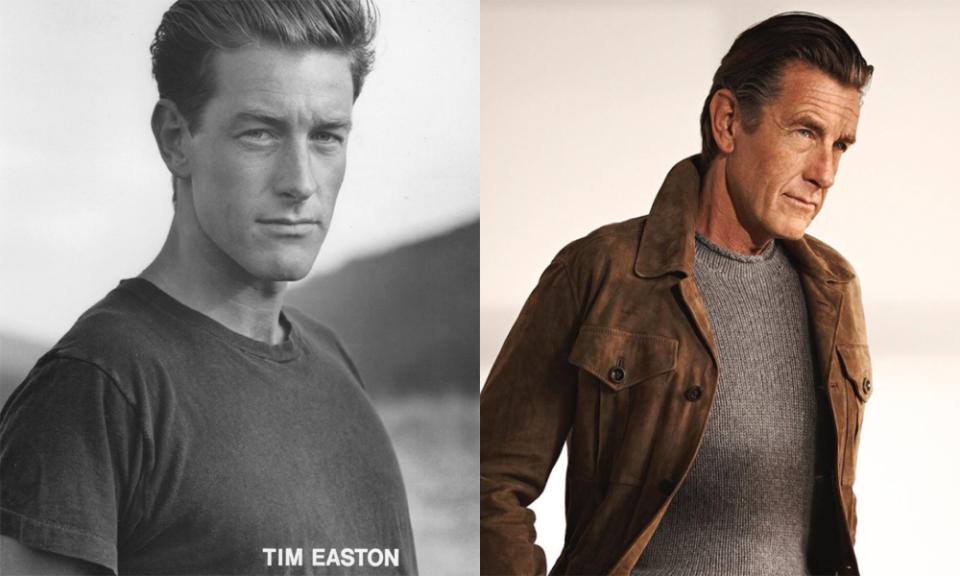
Facetiming me from a friend’s apartment in New York, where he was visiting to walk in the Ralph Lauren show — Tim Easton is as handsome now as when I first spotted his picture on the wall of the Macy’s Ralph Lauren department as a kid. (Admittedly, he is probably one of my earliest crushes as a result.) Easton is Ralph Lauren, with all the classic good looks of Jimmy Stewart or Gregory Peck, he is disarming and relaxed wearing a chambray button-down and rose-tinted glasses. After some time away from modeling, Easton has been a fixture in two recent iconic Lauren runway shows.
Before gracing the pages of every glossy magazine, Easton lived what seems like a million lives. “I’d already had quite a journey before this,” he says. “I was in the merchant Navy for a couple of years. I worked on the Queen Elizabeth the II, QE2, traveled all over the world in the Merchant Navy, and then I worked at a vintage clothing store for a while.”
He remembers a time on the ship when they were docked in New York — someone brought a GQ magazine on board. “I remember looking at these pictures that happened to be Bruce Weber pictures of a shoot in, I think Morocco or something, and Donald Sterzin was the Art Director at the time… it was almost a vision of what was coming for me,” he says. He would go on, of course, to work with both Weber and Sterzin but at the time — he had no idea what was in store for him; he wasn’t even the sort to pick up a fashion magazine he says. But something about those pictures drew him in.
People always told him to model but he says he didn’t think anything of it, until one day he met a stylist who had some photos taken of him. From there, he got an agent, and after an uneventful trip to Paris, he traveled to New York where he met Weber.
One of his first gigs was a shoot with Weber for Calvin Klein; they shot five models and inevitably went with someone other than Tim. But with that rejection, Weber introduced him to Ralph Lauren, who Easton says likely would not have worked with him had he become a face for Calvin Klein — the two brands at the time were (and remain in many ways) competitors.
“So sometimes not getting what you want is the best thing to happen in life,” he says.
Easton looks every bit the English gentleman. Through his work with Ralph Lauren, he has defined prep style and the WASP aesthetic more than anyone in his industry. No one’s face is more synonymous with the glossy Americana adverts of Ivy League men and their beautiful country club wives than Easton’s. Despite that, he’s anything but uptight; like the label he helped define, Easton has all the style and charm of a timeless classic with none of the pretense.
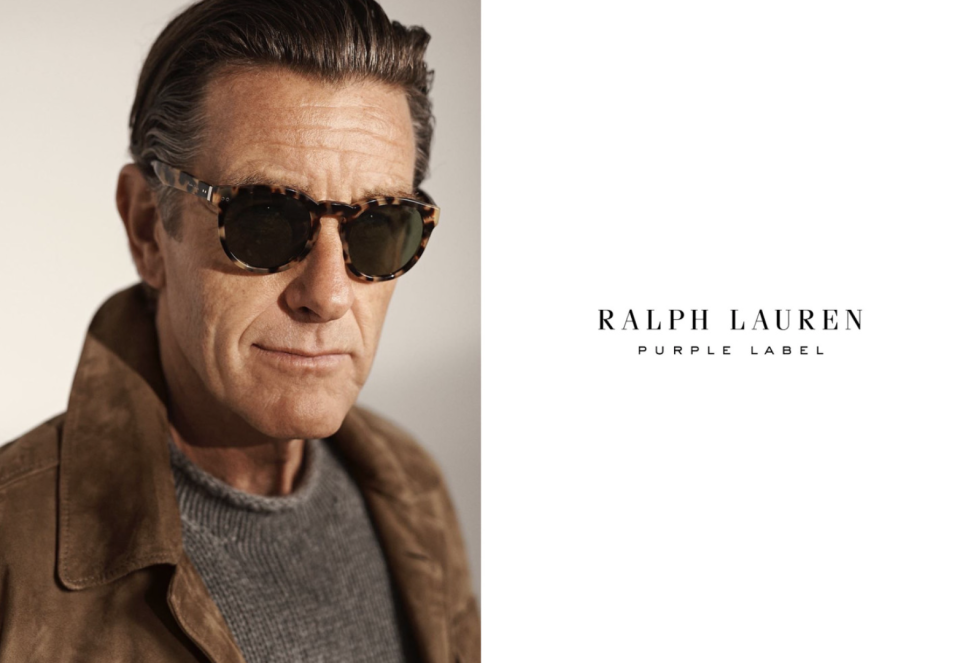
In his free time, Easton is just as down to earth and kind-hearted as he is in his work; he’s a master gardener who received his permaculture design certification in France; he volunteers at Botanic Gardens in Miami and California. He also does gardening work with children in South Central LA, and he beams talking about this work.
He’s also a regular at the local skating rink.
“I came to LA and the nightlife wasn’t like New York,” he says. “And then somebody took me to the skating rink and it was all the music I grew up with in England, yet there was an activity to do. And so, I started going to the skating rink and I really fell in love with that.”
Easton’s Instagram is filled with videos of evenings at the roller rink — grooving along to R&B and hip-hop. In most videos, he’s one of the only white people in the room, but he fits in all the same.
“It’s a beautiful family there, you see the same people every week,” he says. “And we travel to different skate parties. So, I love that.”
In our wide-ranging conversation, I found Easton to be down to earth, cool as they come, and gracious as they get. It’s that same set of qualities that has, along with his singular looks, helped him stay in the modeling industry for so many decades.
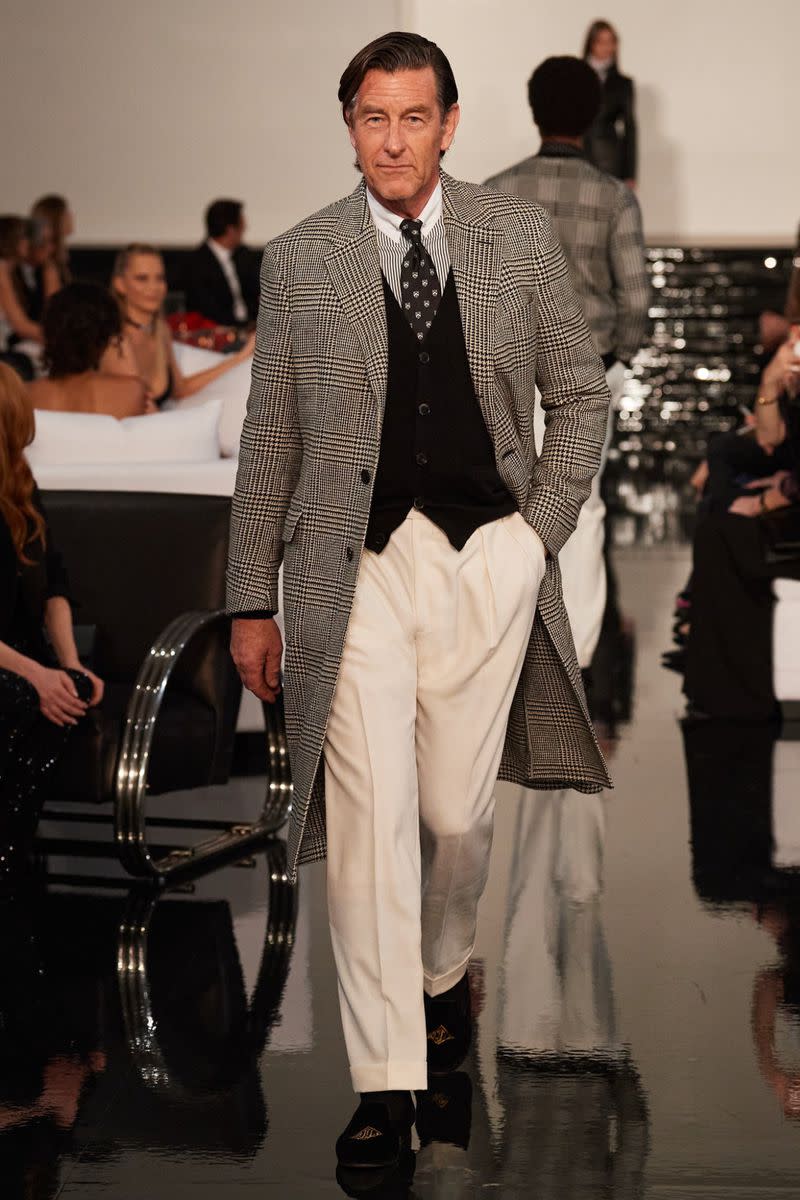
“I’d be on jobs sometimes with guys that are complaining about, ‘How many more pictures do we have to do’ or, ‘What food are they giving us for lunch?’ And I’ve been like, ‘Don’t complain.’ Because I’ve done all those other jobs, where you work 16 hours a day, seven days a week. And so to me, it was like, okay, we work a couple of extra hours over because we need to get the shot, but I’m not going to complain about it.”
He says people with sour attitudes usually don’t get invited back to future gigs, and says that with age he learned that little things — helping carry clothes on set, checking in on the kind of day someone was having — went a long way to making the set a better and more enjoyable place.
At times in our conversation, Easton seems surprised, even confused, at how enamored people are of him. He talks about the messages he gets on Instagram from folks and instead of expressing that cliched annoyance at fans trying to get in touch, he’s excited and flattered at the impression he’s made on people over the years. He recounts specific interactions; fans who have shared with him that he inspired them to buy their first tie, and people who had his picture on their dorm room walls.
Easton has watched his role in the industry change over the years — he has gone from being the husband in ads to the dad — a couple of times he’s been the granddad, a role he says he’s still adjusting to seeing himself in. “But whatever you want me to do,” he says, “I’m fine, I enjoy it all, whatever it is.” He hopes to take on more commercials and theatrical-style work. “It’s always fun to tell a story,” he says.
Recently, he returned to his roots and walked in a recent Ralph Lauren show, and Easton says younger male models in the show approached him to talk about his career.
“They all said they all looked up to me and were calling me OG and calling me… I don’t know, they couldn’t be nicer,” he says.
Photos and video from the show of Easton gliding along the runway are really all you’d need to see to understand why he’s earned the status he has in the industry, and onlookers seemed to agree.
“I had a few people text me or call me after the show and say, ‘It was good to see you show those young bucks how to do it on the runway.’”
Alvin Clayton – The Million Dollar Smile
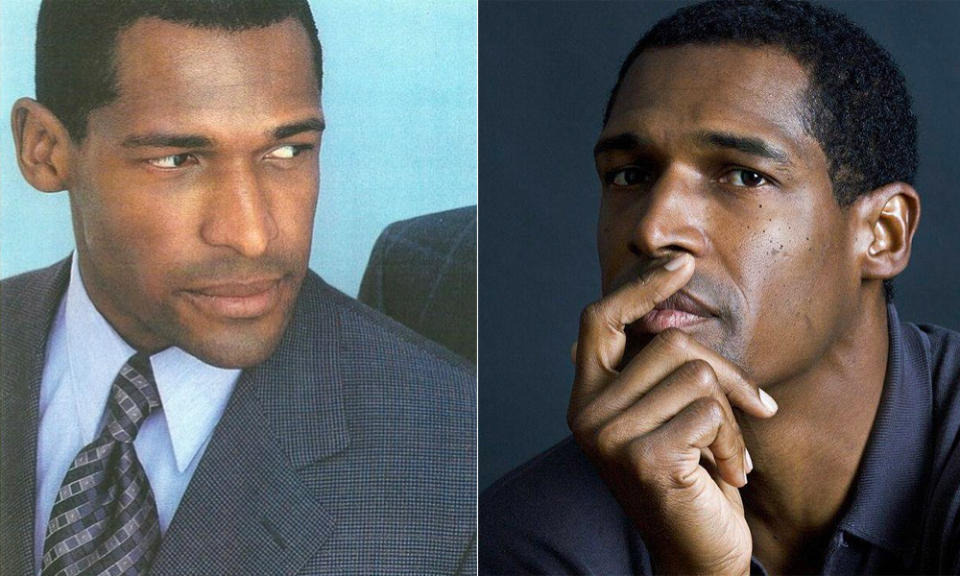
I’ve done a lot of interviews with people in entertainment and despite what anyone tells you because they’re trying to seem above being starstruck, it’s always exciting to see one of the ‘beautiful people,’ up close and personal. Alvin Clayton was the first model I interviewed for this piece, and when he picked up our video call, I saw, for the first time with my eyes, what makes models different from the rest of us.
Clayton is, in a word: breathtaking. He looks as though he’s been carved from stone; everything about him, from the way he moves his hands when he speaks to how he laughs with his whole upper body feels like watching Mikael Baryshnikov dance — there’s an ease and a grace that feels like art just to witness.
And when he smiles, his face brightens with a glow that feels almost fictional.
People always told him he should model, so he took a chance on it — he traveled to New York and went to Wilhelmina models. “They told me how difficult it was for African-American models, the whole spiel, which it was,” he says. “Back then, they had a handful of black models with the agency and we each fit a category. They had a dark skin model, a light skin, and they would protect that position back then. They said they would try me, give me a shot.”
He started doing gigs here and there, and some smaller catalogs. Every male model at the time, he said, wanted to be in GQ but he didn’t feel ready — he says he saw models with bigger portfolios who still hadn’t made the pages of the glossy men’s mag so why would they take him? After building his portfolio for six months, he finally felt ready — he told his agent, who called them right away. “It was about a five-minute interview,” he says. “It was a nice, friendly conversation. I got back to the agency and my agent was like ‘How did it go?’ I said it went fine, and she replied ‘It must have been really fine because they just booked you for a job tomorrow.’”
“I was excited but I was in a little bit of a dilemma because every single guy that I had ever seen in GQ before, especially black males, they had that somebody just killed your dog look,” he jokes. “You know that GQ look?” His portfolio was all smiles. “I just said, you know what? I’m going to take a chance and be me.” He worked with photographer Arthur Elgort on what would be a four-page shoot for the magazine. By the time he returned to the agency that day, he was booked for another shoot the following day with Oliviero Toscani.
“It was another four pages, and it was supposed to be for separate issues but something happened and it came out in the same issue,” he says. “It was the first time that a person of color had eight full pages in GQ and that made my career.”
Clayton’s million-dollar smile isn’t just about looks though; the model prides himself on his courteous nature on set, and it’s that humble and thankful outlook that he credits his longevity in the industry, too.
“I was the guy on set who — I realize we all met at six o’clock in the morning, right?” he says. “The stylist is probably up an hour before us. We’re there smiling all day with photos being taken. When it’s time to go back to the hotel, what does it take me to help the stylist get their stuff onto the motor home? You know what I mean? I think just treating people kindly, just being authentic and caring, I think that has carried on into people liking to work with you know.”
Clayton had a booming modeling career for decades before retiring to focus on other projects. These days he’s an artist and a restaurateur — his restaurant Alvin and Friends serves southern and Caribbean cuisine; they have live jazz on Fridays and Saturdays and a jazz bench on Sunday.
“When I first started modeling, I worked as a waiter and I actually liked meeting different people and actually having that experience,” he says. Opening a restaurant seemed like a logical next step for Clayton when he was looking for his next venture after modeling. He met restaurateur Brad Johnson through friends and invested in one of his restaurants along with a few other high-profile investors — Denzel Washington among them.
When he’s not restaurateuring, Clayton is honing his skills as an artist; an avid fan of Matisse (one of his daughters is named after the painter) he learned by copying his work before branching out into Clayton originals. One day, his agent came by his loft and admired the works that hung on his walls; she suggested he have a show with a friend of hers who had a galley in Soho. Two months later, he was featured in a special on successful models that showcased his artwork. “That’s how I became an artist,” he says.
Since then, his art career has boomed; it’s been in feature films and he has a piece at the Smithsonian in Washington, D.C. “I just had a show at the Wrights Art Center that was their most successful show,” he beams. “So now I’m actually an artist that models.”
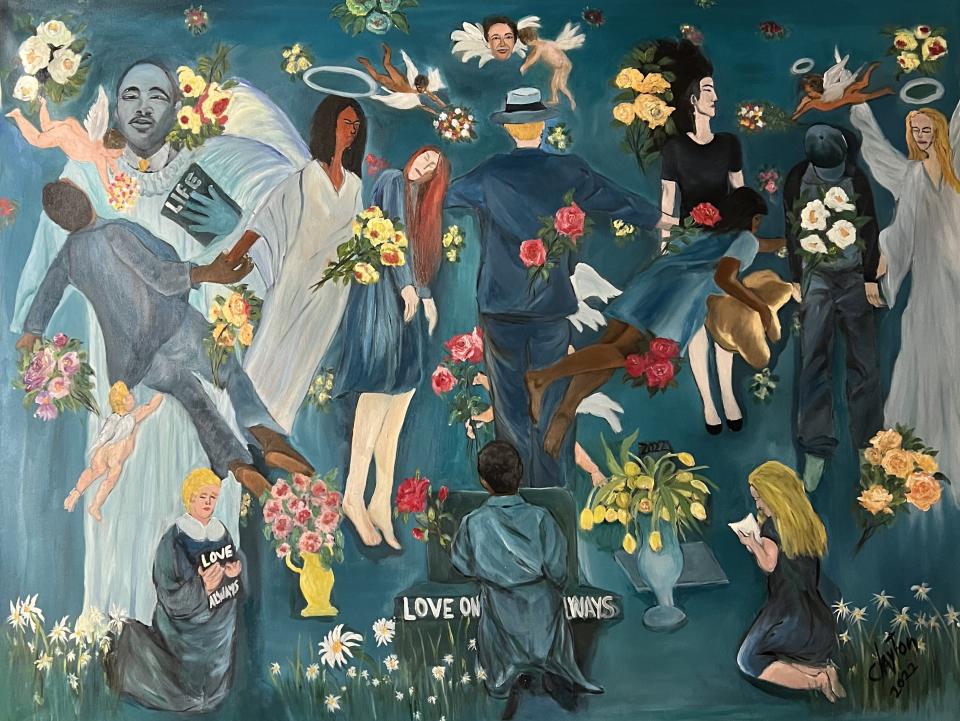
And it was even his art career that pulled him out of retirement from modeling. “Two years ago I did a show. I was just being affected by the political climate around me,” he says. “In order to kind of deal with that, I started painting some political pieces.” His work was featured in a gallery in New Rochelle, where he now lives with his wife and their four children — Timothy, Matisse, Oliver and Bella. Word got around about his show, and all the way to someone at IMG, who reached out to Clayton to say they were interested in representing him. “I think now they’re looking for people that have a little bit more than how you look,” he says. “They want to know, ‘What do you have to say?’ I think especially as an older model, or an aged model, mature. I think you bring, you bring a certain amount of experience to who you are as a person.”
He talks at length about a piece he’s working on that examines themes of mortality, loss, and the overwhelming grief that has loomed over the last few years. It’s called Transition. “There seemed to be so much death and dying around me lately that it was kind of overwhelming,” he says. He talks about visiting a friend in the hospital shortly before she passed away from cancer; her room filled with flowers. “We’ve got to give people their flowers while they’re here,” he says. And while the painting does deal with death and dying, it also has warmth and beauty too – he says, to remind us of the lives we have while we are here.
I was curious, with all that experience, and with his plentiful successes, what advice he imparts on his children.
“You have to do you and enjoy what you’re doing,” he says. No matter what profession you’re in he says — give it your all; when you’re in an interview do your absolute best. But when you walk out the door, accept that it’s no longer in your hands.” He encourages them to find their worth in their own self image, and not in how others judge them.
“Even if you’re not getting accolades from somebody else, if you’re enjoying that, that’s what you’ve got to do,” he says. “You can’t let somebody stop you. You’ve got to keep going and persevering.”
He also tells them to stay humble. “I tell them, never believe your own press,” he says. Clayton never felt like he was singular in his abilities; instead, he says he’s been blessed to have the opportunities he has. “I tell my kids all the time, there’s a lot of other people who could be doing the exact same thing that I’m doing.”
John Pearson – The World’s First Male Supermodel
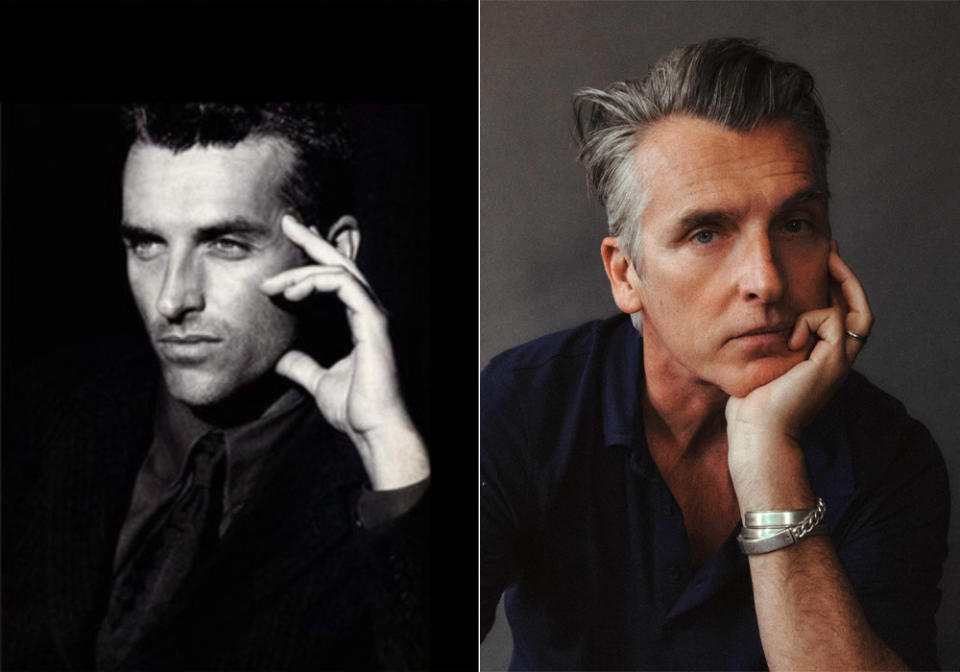
The term “wife guy” gets thrown around a lot; a common moniker used on social media to denote that a man doesn’t just love his wife — he adores her. John Pearson is the consummate, the aspirational, the model wife guy.
When I researched Pearson for this piece, the same title came up over and over: the world’s first male supermodel. With facial features sharp as razors, a smile that would put any Ken Doll to shame, and a Cary Grant-like charm, it’s a fitting title. And as a woman growing up, we’re socialized to believe that men who look like gods, act above reproach like them too; that they’re womanizers, skirt chasers, and that they’re loath to settle down because women just fall at their feet.
For approximately the first 15 minutes of our conversation Pearson spoke, nay, gushed, about his wife. When I started off with the standard pleasantries asking about his day he immediately started telling me about how his wife — creative director and stylist Alison Edmond — was coming off a busy weekend working with clients at the Oscars.
“It was relentless, because she did the entire award season,” he says. “I just drive her and feed her and make sure she gets to bed for the most part… She’s the talented one.” When I opened our interview with some conversation about the fashion and entertainment worlds, he once again defers to her. “You should speak to her,” he says. “I mean, she was creative director of Harper’s Bazaar England for 12 or 14 years. She was West Coast editor of American Bazaar during the nineties under her mentor, Liz Tilberis. She started out in the art department, British Vogue, under Anna Wintour. So her pedigree is extraordinary.”
The pair have been together since they were 17 — he goes on to direct me to her Instagram, being sure to spell her name so I don’t miss it. “Of course I’m biased — but I’m not — because she is brilliant at what she does and she always does,” he says. “ What’s extraordinary is not only has she managed to stay in this highly competitive game… But she’s also done it with grace and dignity and always remaining a very lovely human being. And on top of that, she’s brought up three incredible children, our children, and I don’t know how she does it. She’s a wonder woman, she really is.”
He tries to apologize for gushing for so long (anytime a man wants to set the example that they should revere their wives, I’m all for it). “I mean everything I say, and I’ll sing it from the rafters. I’m her biggest fan,” he says.
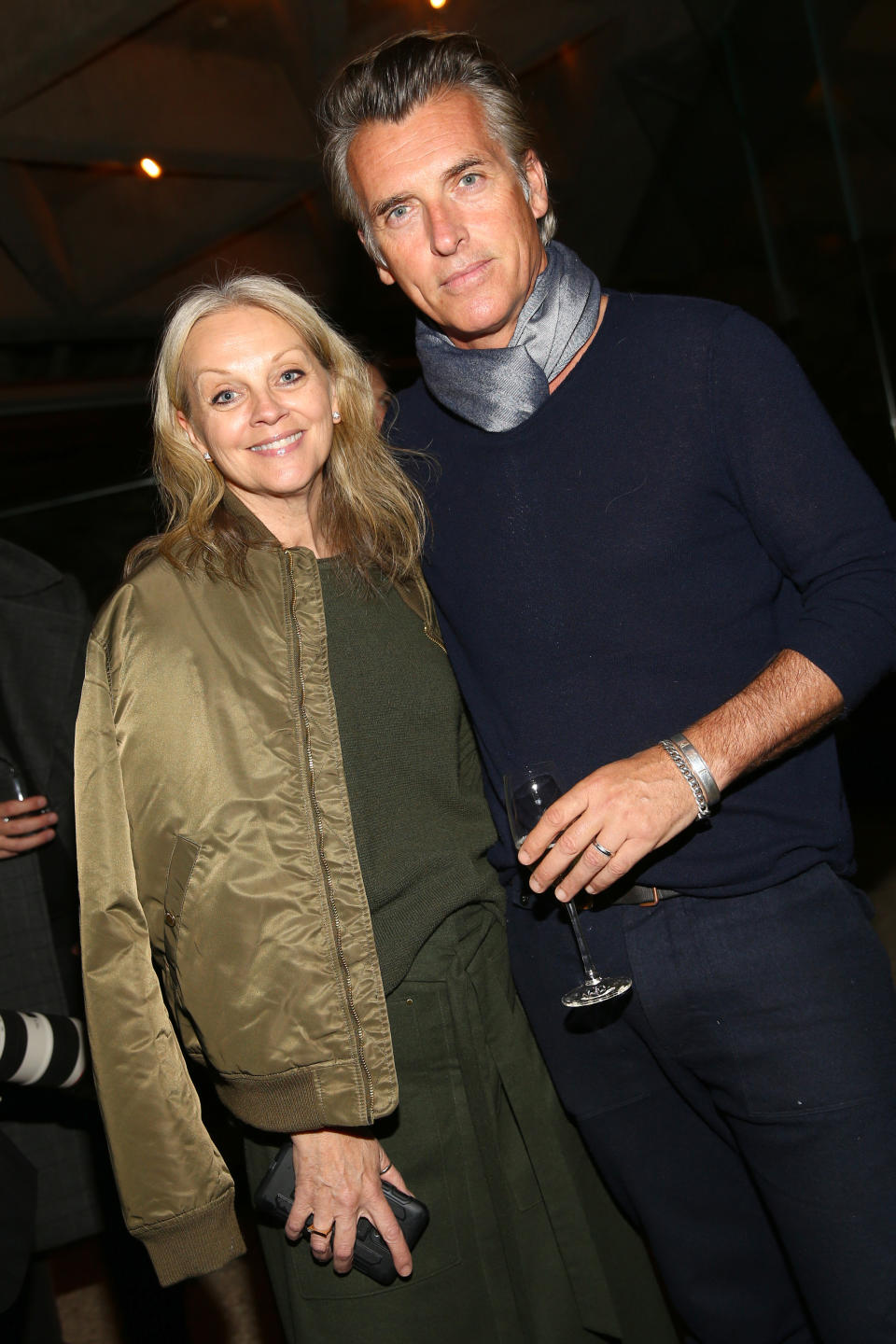
Pearson is being humble, of course, with one of the most prolific modeling careers, and a men’s magazine under his tutelage, I’m certain his wife would rave about him all the same.
Pearson was born and raised in Northern England. At 12, he started working in a market in Hull, selling fruits and veggies to make money; he’d bring a few bags of fruit home at the end of the day and sell them to his neighbors on the cheap. As a kid growing up on a council estate, along with the brothers who lived next door, he’d clean windows for the elderly folks in the neighborhood. At 16, he became a manager of a trendy denim shop in town called Jean Genie, and two or three years later someone came in and asked if he’d like his picture taken. “And of course being a cocky rockabilly, wannabe Montgomery Clift/James Dean, I said, sure,” he says. Still, he was wary so he brought his sister to the shoot with him.
Once he was there, he was a natural in front of the camera and his sister sent the shots off to a magazine called Look Now, in London — a culture magazine for young people. They invited him to London to do an editorial.
“I had my cassette with me with all the music on it, so I kind of ran the music and had an amazing day,” he says. They paid me one hundred and twenty pounds and I couldn’t believe it because I was making two pounds, fifty a day in the market and not much more in the jean shop.” He was asked back about a month later to do the cover of the magazine and he eventually made the move to London with plans to go to the Royal Academy to be an actor, but within a week of getting there, he got booked for a commercial which paid well, so he started doing that.
He spent time traveling; Japan, New York, Paris, Milan. In 1986, he and a friend moved to New York with no real plans — and all the big agencies in the city had turned him down. But one small agency, Ice, took a chance on him. They sent him to Guadeloupe for an editorial for Per Lui, and the French brand, Newman.
It was all up from there; photoshoots with Cindy Crawford, Christy Turlington, Naomi Campbell.
“And then thereafter, it just went bonkers and it continued to go bonkers for about 15 or 20 years,” he says. “And it was extraordinary.”
It would be easy to credit Pearson’s staying power in the industry to his — to put it frankly — otherworldly good looks. But after being on the phone with him just a short time, it’s apparent that it’s his disarming warmth and his gentlemanly politeness that also carried him through an industry that runs on relationships and connections. And he’s conscious of the human element of the industry, and the importance of being an asset — not an annoyance — on set, especially when it comes to how he treats his coworkers; a way of life he credits to growing up close to his two older sisters and his mother.
“My job was really about, if I was working with a girl, was about making them feel good,” he says. “About making them feel comfortable and about making them feel special, or about making the children feel [safe] in this very awkward, strained situation that they’ve been put into during the shoot. So it’s all about being polite. It was all about being kind and considerate. And it is to this day. It’s about how you treat everyone, including the seamstress, the producer, the craft service person, because really, at the end of the day, you’re in a very fortunate position.”
Pearson’s outlook is infectious; you can tell he feels lucky and takes nothing for granted. He is so genuinely proud of the life he’s built and the people he’s built it with. He talks extensively about visiting family back home in England and you can tell, he has not only not forgotten his working-class roots, but they still, to this day, inform his perspective on what he does. “We were all grafters,” he says. “I mean, I’m still a grafter to this day. When I go back, as I said, to see my cousin next week, we’ll get the tractor out and we’ll be digging. I think it’s a working-class thing.”
And it’s a way of life he’s adapted into his latest project — the men’s publication Mr. Feelgood focused on wellbeing and mindfulness, born out of the stagnation of Covid. “So after 35 years of working and traveling the world, working with all the best people — everyone from Helmut Newton to Bruce Weber, Steven Meisel to Paolo Roversi to Pamela Hanson to, you name it, Richard Avedon, the works, and all the modern ones too, or a lot of the modern ones, I found myself not being able to travel. I was stuck. I couldn’t go anywhere.”
A friend who works as a journalist, Pete Samson, called and invited him to lunch to discuss an idea for a publication where men could have honest conversations about culture, science, art, wellness, spiritual and mental health. “To me, it’s the idea of being sat around a campfire with people under a big beautiful sky,” he says. “It’s about pushing back against the toxicity of our times, politically, environmentally and socially, educationally and economically, and just trying to… I know it sounds tepid and not sanctimonious but sentimental, but it really is about kindness.”
Through Mr. Feelgood, he says, he hopes to “walk the path of grace” and to embrace his curiosity about life — to seek understanding in each other through learning. “We all need to just bloody meditate and make love, not war,” he says.
Above all though, it’s clear that Pearson’s proudest achievement in his life is his children; his family. And that same outlook of gratitude, kindness, acceptance and openness pervades his parenting and how he speaks about his role as a father.
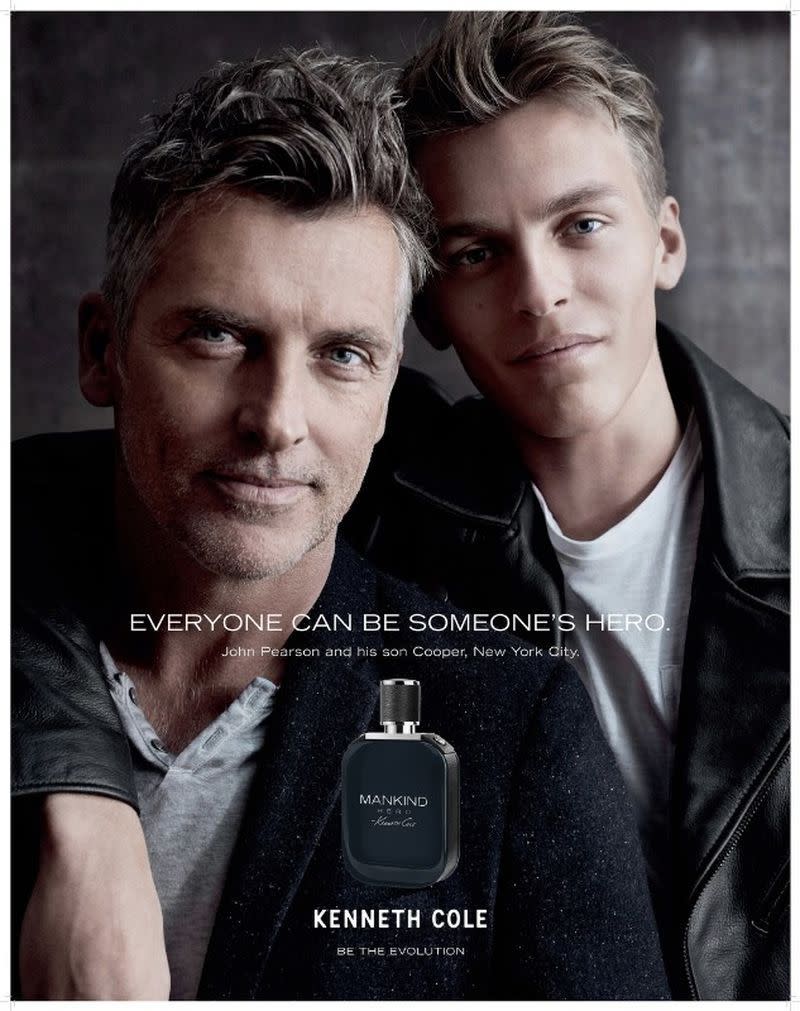
“It was always vitally important to me to be the father [I wanted to be], because my dad was a great father, but he died when I was 11,” he says. “He was 45. So when my wife went away to do the collections with the magazine twice a year, I would always be at home with [our] children. And we’d have help, yes, but I did most of the work because I wanted to. I wanted to be that father for my boys and my daughter, because I wanted to be present for them. And that’s always been my role and continues to be my role, even though now they’re like parents to me.”
He talks about his children with the same pride he speaks about Alison and you can sense a sort of awe that he gets to witness these people who he clearly loves so much. He says he’s proud of their work ethic, and their character — how they treat each other, and their outlook on the world.
“I’m so proud of them when they engage with people. When they talk with people, it’s real,” he says. “They’re really interested in doing something substantial, and they’re fucking funny and brilliant as well.”
More Top Deals from SPY
Best of SPY
Gallery: The 10 Best Costume Ideas for a James Bond-Themed Halloween
Upgrade Your Loungewear Game With the Best Men's Loungewear Pieces of 2022
Click here to see more up-to-date holiday deals!

